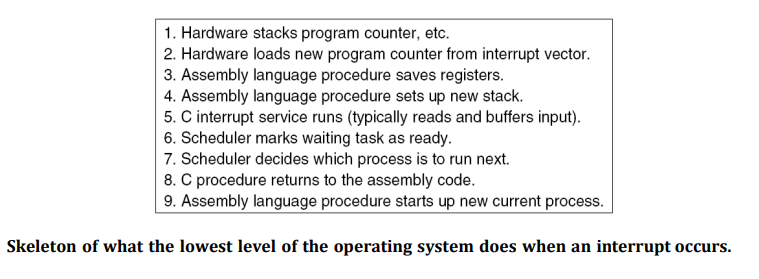Operating System – Interrupt Long Questions Answers
 Here in this section of Operating System Long Questions and Answers,We have listed out some of the important Long Questions with Answers on interrupt which will help students to answer it correctly in their University Written Exam.
Here in this section of Operating System Long Questions and Answers,We have listed out some of the important Long Questions with Answers on interrupt which will help students to answer it correctly in their University Written Exam.Lists of Long Descriptive type Questions that may be asked in Written Exams.
- (1)What is interrupt? How it is handled by an OS?.
Question-1 What is interrupt? How it is handled by an OS?
- A software interrupt is caused either by an exceptional condition in the processor itself, or a special instruction in the instruction set which causes an interrupt when it is executed.
- The former is often called a trap or exception and is used for errors or events occurring during program execution that is exceptional enough that they cannot be handled within the program itself.
- Interrupts are a commonly used technique for process switching.
- Associated with each I/O device class (e.g., floppy disks, hard disks etc…) there is a location (often near the bottom of memory) called the interrupt vector.
- It contains the address of the interrupt service procedure.
- Suppose that user process 3 is running when a disk interrupt occurs.
- User process 3’s program counter, program status word, and possibly one or more registers are pushed onto the (current) stack by the interrupt hardware.
- The computer then jumps to the address specified in the disk interrupt vector.
- That is all the hardware does.

- From here on, it is up to the software, in particular, the interrupt service procedure.
- All interrupts start by saving the registers, often in the process table entry for the current process.
- Then the information pushed onto the stack by the interrupt is removed and the stack pointer is set to point to a temporary stack used by the process handler.
- When this routine is finished, it calls a C procedure to do the rest of the work for this specific interrupt type.
- When it has done its job, possibly making some process now ready, the scheduler is called to see who to run next.
- After that, control is passed back to the assembly language code to load up the registers and memory map for the now-current process and start it running.
- Interrupt handling and scheduling are summarized in Figure above.